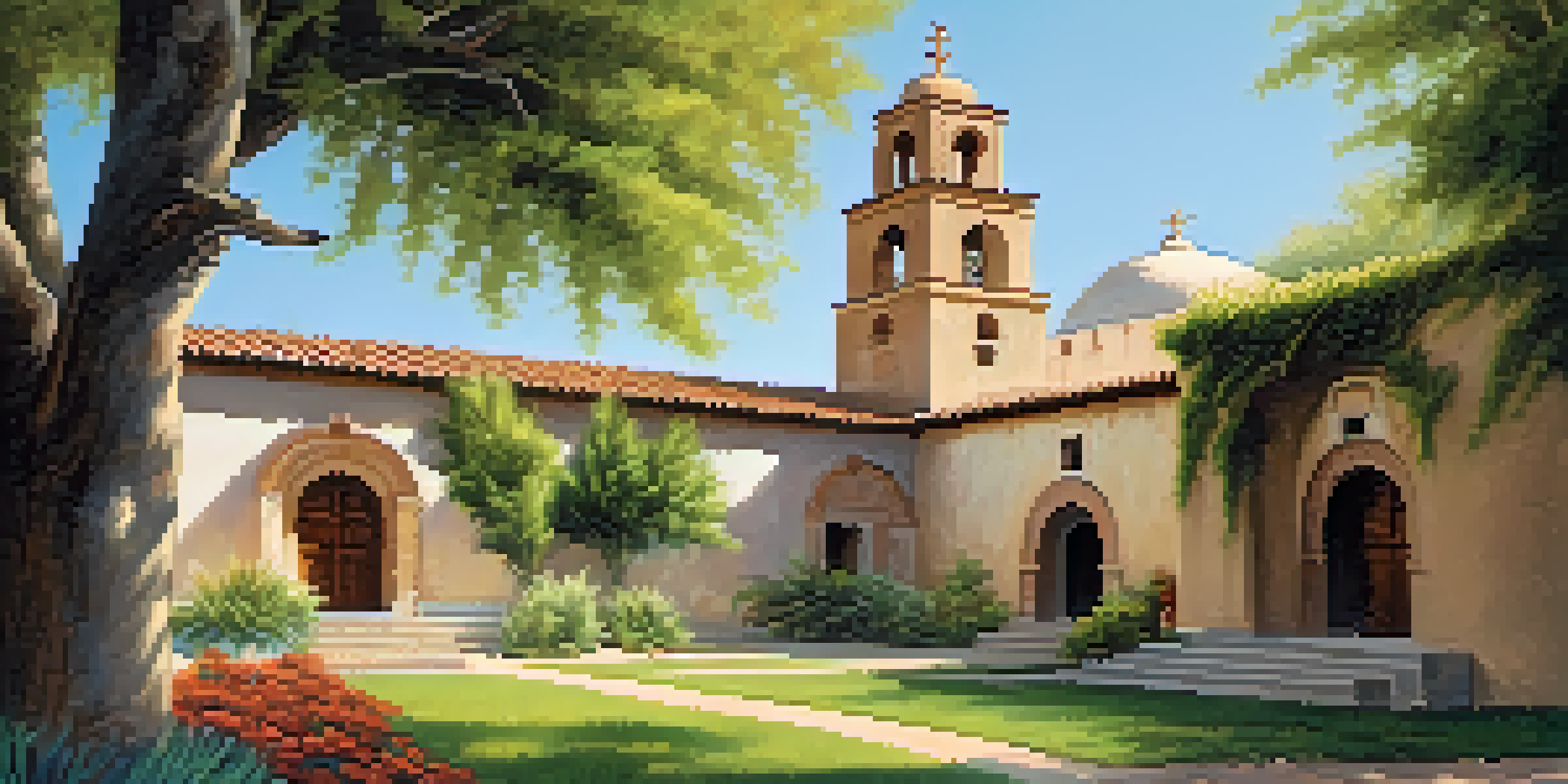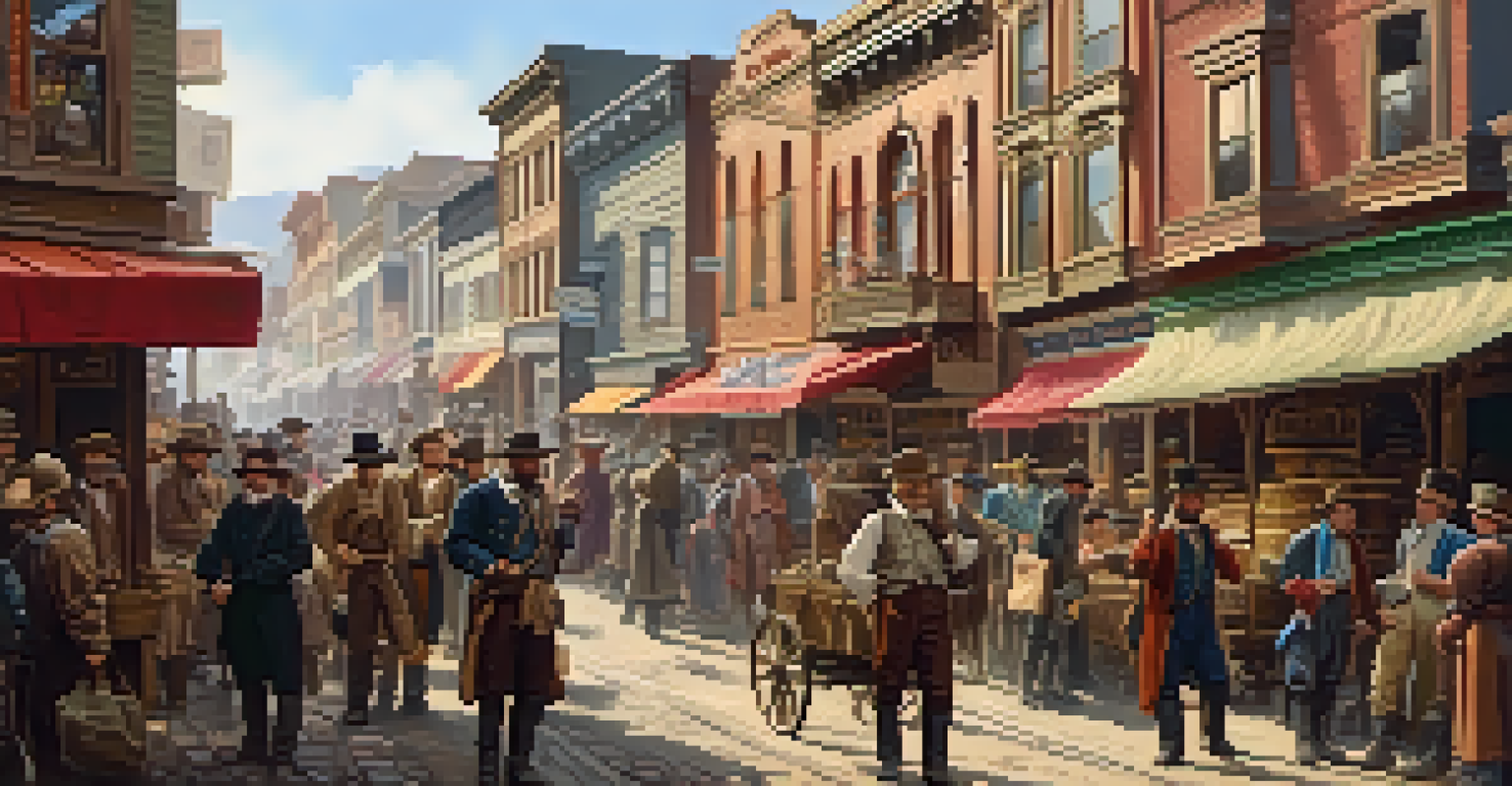San Francisco's Early Days: From Mission to Metropolis

The Founding of Mission San Francisco de Asís
In 1776, Spanish settlers established Mission San Francisco de Asís, marking the beginning of San Francisco's European history. This mission, often referred to as Mission Dolores, was part of a larger effort to spread Christianity among the Native Americans. The mission's location near the bay was strategic, offering access to resources and trade routes.
San Francisco is a city that knows how to take a hit and come back stronger than ever.
The mission's construction utilized local materials and was influenced by Spanish architectural styles, creating a unique blend of cultures. As settlers arrived, the mission became a hub of religious and agricultural activity, attracting more people to the area. Despite its humble beginnings, Mission Dolores laid the groundwork for a community that would flourish in the coming years.
As the mission grew, it not only served as a spiritual center but also as a gathering place for the local population. The blending of Spanish and Native cultures during this time created a rich tapestry of traditions that would influence the region's development. This early phase set the stage for what would eventually evolve into a vibrant city.
The Gold Rush: A Catalyst for Growth
The discovery of gold in 1848 transformed San Francisco almost overnight. This event attracted thousands of hopeful prospectors and fortune seekers, turning the small mission town into a bustling metropolis. The population swelled from about 1,000 to over 25,000 in just a few years, leading to rapid urbanization.

As people flocked to the city, businesses sprang up to support the growing community. From saloons to general stores, entrepreneurs seized the opportunity to cater to the needs of miners and their families. This economic boom marked a turning point in San Francisco's history, establishing it as a key player in the westward expansion of the United States.
Mission Dolores: A Cultural Foundation
Established in 1776, Mission San Francisco de Asís became a central hub that blended Spanish and Native American cultures, laying the groundwork for the city's rich community.
However, the Gold Rush also brought challenges, including lawlessness and the struggle for resources. The city had to adapt quickly to these changes, implementing new laws and establishing a form of governance. Despite the chaos, this period laid the foundation for the city's vibrant and diverse character.
Cultural Melting Pot: Diverse Influences
As San Francisco grew, it became a melting pot of cultures, with immigrants arriving from various parts of the world. The influx of Chinese, Irish, Italian, and many others contributed to the city's rich cultural landscape. Each group brought its unique traditions, food, and festivals, enriching the community.
The beauty of San Francisco is that it is a city of dreams, where every person can find a place to belong.
This cultural diversity is perhaps best exemplified in the neighborhoods that sprang up, such as Chinatown and North Beach. Chinatown, established in the 1850s, became the first and largest Chinese community outside Asia, while North Beach emerged as the heart of Italian culture. These neighborhoods not only provided a sense of belonging for immigrants but also enhanced the city's overall charm.
However, this diversity also led to tension and conflict at times, as different groups vied for resources and recognition. Yet, the interplay of cultures ultimately contributed to a dynamic atmosphere that shaped San Francisco's identity. The blending of traditions created a unique, vibrant city that would attract even more people in the years to come.
The Impact of the 1906 Earthquake
On April 18, 1906, a devastating earthquake struck San Francisco, followed by raging fires that destroyed much of the city. The disaster was a profound turning point, as it leveled neighborhoods, displaced thousands, and tested the resilience of the community. In the aftermath, the city's recovery efforts became a symbol of hope and determination.
Rebuilding San Francisco presented both challenges and opportunities. The city adopted modern building codes and infrastructure improvements, leading to a more resilient urban landscape. This period of reconstruction also sparked innovation and architectural advancements, reshaping the city into a more organized and aesthetically pleasing environment.
Gold Rush Transforms the City
The 1848 discovery of gold rapidly turned San Francisco into a bustling metropolis, attracting thousands and spurring significant economic growth.
The earthquake and subsequent rebuilding efforts fostered a sense of unity among residents. People from diverse backgrounds came together to help one another, demonstrating the strength of community spirit. This collective effort not only restored the city but also solidified its reputation as a place of resilience and renewal.
The Rise of the Financial District
As San Francisco rebuilt after the earthquake, its financial district emerged as a central hub for commerce and trade. The city became a vital banking and financial center on the West Coast, attracting businesses and investors from across the nation. High-rise buildings began to dominate the skyline, symbolizing the city's growth and ambition.
The establishment of the Bank of California and other financial institutions marked the beginning of a new economic era for San Francisco. This growth not only provided jobs but also attracted skilled workers and entrepreneurs, further fueling the city's development. The financial district became a bustling area, filled with energy and opportunity.
However, this rapid growth also led to challenges, including increased competition and the need for infrastructure improvements. The city had to adapt to the changing economic landscape while ensuring that it remained accessible and livable for its residents. The financial district's success played a crucial role in shaping San Francisco's identity as a global city.
Civic Pride and Cultural Developments
Throughout the early 20th century, San Francisco blossomed as a center for arts and culture, fueled by a growing sense of civic pride. Institutions like the San Francisco Symphony and the San Francisco Museum of Modern Art emerged, showcasing the city's commitment to cultural enrichment. These developments reflected the diverse backgrounds of its residents and their shared love for the arts.
Events like the 1915 Panama-Pacific International Exposition celebrated the city's recovery and showcased its cultural achievements to the world. This exposition not only highlighted San Francisco as a vibrant city but also attracted tourists and investors, further solidifying its economic standing. The spirit of innovation and creativity was palpable during this era.
Resilience After the 1906 Earthquake
The devastating earthquake of 1906 prompted a united recovery effort, leading to urban innovations and reinforcing the city’s spirit of resilience and renewal.
Moreover, the city's cultural scene continued to evolve, with jazz clubs, theaters, and art galleries becoming popular destinations. The blending of various cultural influences created a unique artistic landscape that resonated with both locals and visitors. This commitment to the arts and culture became a defining characteristic of San Francisco, setting it apart from other cities.
San Francisco Today: A Legacy of Transformation
Today, San Francisco stands as a testament to its rich history and transformation from a mission site to a bustling metropolis. The city's iconic landmarks, vibrant neighborhoods, and diverse communities reflect its dynamic past. While it has embraced modernity, echoes of its early days can still be felt throughout the city.
The legacy of the Gold Rush, the resilience shown during the 1906 earthquake, and the cultural melting pot all contribute to San Francisco's unique identity. It's a place where history and innovation coexist, attracting people from all over the world. This blend of old and new creates a city that is ever-evolving yet rooted in its rich heritage.

As San Francisco continues to grow and change, it remains committed to preserving its history while adapting to contemporary challenges. The journey from mission to metropolis is not just a historical narrative; it's an ongoing story that reflects the spirit of its people and their unwavering love for this remarkable city.